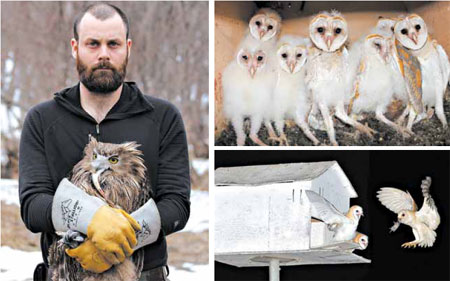Scientists unraveling the mysteries of owls
Updated: 2013-03-10 07:50
By Natalie Angier(The New York Times)
|
|||||||
|
Jonathan Slaght of the Wildlife Conservation Society with a Blakiston's fish owl, the world's largest owl. Young barn owls, top, donate food to hungrier siblings. Scientists are trying to decipher the complex series of calls, trills and hoots of barn owls. S. Avdeyuk / Amur-ussuri centre for avian biodiversity; top and above, photographs by amir ezer |
WASHINGTON - David Johnson, director of the Global Owl Project, is working with researchers in 65 countries to compile a vast database and celebration of the world's owls, with descriptions, natural history, genetics, vocalizations, population estimates, owl myths and legends.
Westerners love owls, he said, a tradition that dates back at least to the ancient Greeks and the association of owls with the wise goddess, Athena, and her gray "shining eyes." In some countries, though, owls are seen as bad omens and harbingers of death - perhaps, Mr. Johnson proposed, because owls often nest in cemeteries, where trees are left to grow undisturbed and the nesting cavities are comfortably large.
In the Western imagination, the owl, which can rotate its head up to 270 degrees, surely vies with the penguin for the position of My Favorite Bird. "Everyone loves owls," said David J. Bohaska, a paleobiologist at the Smithsonian's National Museum of Natural History in Washington.
Yet for all the apparent familiarity, only lately have scientists begun to understand the birds in any detail. Researchers have discovered, for example, that young barn owls can be generous toward one another, regularly donating portions of their food to smaller, hungrier siblings - a display of altruism that is thought to be rare among animals.
The scientists also discovered that barn owls express their needs and desires to each other through a complex, rule-based series of calls, trills, barks and hoots, a language the researchers are now seeking to decipher.
"They talk all night long and make a huge noise," said Alexandre Roulin of the University of Lausanne in Switzerland, who recently reported on barn owl altruism in the journal Animal Behaviour with his colleague Charlene A. Ruppli and Arnaud Da Silva of the University of Burgundy in France.
Other researchers are tracking the lives of rarer and more outlandishly proportioned owls, like the endangered Blakiston's fish owl of Eurasia. Nearly a meter high, weighing up to five kilograms and with a wingspan of two meters, Blakiston's is the world's largest owl, according to Jonathan Slaght of the Wildlife Conservation Society's Russia program. It could easily look like a bear in a tree. This powerful predator can pull from the river an adult salmon two or three times its own weight.
Ferocity is essential for a bird whose range extends across northeastern China, the Russian Far East and up toward the Arctic Circle, one that breeds and nests in the dead of winter. Dr. Slaght's colleague Sergei Surmach videotaped a female sitting on her nest during a blizzard. "All you could see at the end was her tail jutting out," Dr. Slaght said.
Aeronautical engineers are studying owls for clues to better wing designs. Many owl species are renowned for their ability to fly almost silently, without the air whooshes that might warn prey of their approach.
The bulk of the wing is broad and curved and is veined with velvety down plumage to help absorb sound. Moreover, the feathers at the edge of the wing are serrated to effectively break up and smooth out air turbulence.
At a meeting of the American Physical Society last fall, researchers from Cambridge University in Britain proposed that well-placed perforations in an airplane wing could have a similar smoothing effect on turbulence, leading to quieter and more fuel efficient flights.
Owls date back 60 million years or longer, and they're found in nearly every type of habitat. Some 229 species are known, and the list keeps growing: last summer, two new species of hawk owl were discovered in the Philippines, and in February researchers reported on a new species of screechlike owl from the island of Lombok, Indonesia.
Species like the barn, barred, screech and horned have some of the keenest auditory systems known.
Professor Tim Birkhead of the University of Sheffield in Britain points out that the owl cochlea is "enormous" and densely packed with sensory cilia. The barn owl, for example, has three times the number of hair cells expected for its body size.
Then there is the owl's flat face, also called the facial disk- pie-shaped in some species, heart-shaped Kabuki in the barn owl. The facial disk serves as a kind of satellite dish, to gather sound waves, directed to the owl's ears by specialized feathers.
The birds own the night and hunt tirelessly, too. By one estimate, a group, or "parliament," of 10 owl families living in a barn in Florida cleared the surrounding sugarcane fields of about 25,000 cotton rats a year.
The New York Times
(China Daily 03/10/2013 page11)
